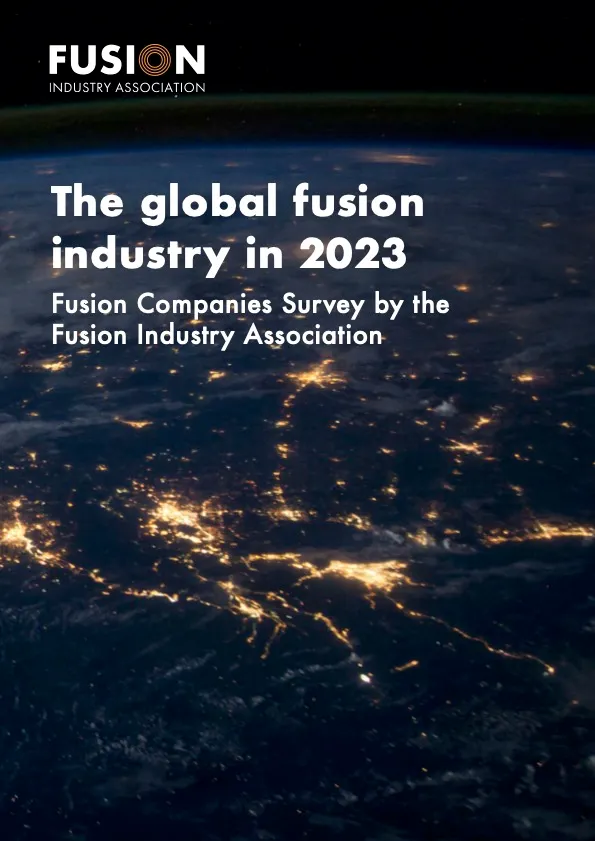FIA’s 2023 report shows industry growth and optimism
On Wednesday 12th July, the Fusion Industry Association (FIA) released their 3rd fusion industry report, “The Global Fusion Industry in 2023”, launching it at the SOFE event in Oxford, UK.
The FIA surveyed 43 private fusion companies and the report gives aggregate industry statistics as well as a directory of participating fusion companies.

© Fusion Industry Association
Here are three key insights from the report.
1. Private investment in fusion continues to grow and, with that, job opportunities in fusion.
Overall investment in the fusion industry has grown to $6.2 billion, up by $1.4 billion on last year.
The growth in investment is lower than the figure from 2022 (which was dominated by the $1.8bn raise by Commonwealth Fusion Systems and $500m by Helion in late 2021) but this time the investment is far more spread out. The additional funding comes from 27 individual investments, which include $250m for TAE, $200m for ENN, $79m for Kyoto Fusioneering, $55m for Energy Singularity, and many more.
That investment is particularly noteworthy considering the current global economic climate.
Andrew Holland, CEO of the FIA, stated: “We still saw a few pretty sizeable investments and a growing volume of smaller ones, totalling $1.4bn, in a period where fears of inflation, interest rate increases, and even bank failures led many investors to hold onto their money.”
This year 13 new companies were founded or emerged from stealth mode, which saw a reported increase in the number of fusion jobs of almost a thousand (975), plus an additional ~3,000 jobs created within the supply chain. Moreover, FIA notes this is likely to be an undercount as not all companies responded to this question.
Read more about the fusion supply chain in the recent FIA supply chain report, “The Fusion Industry Supply Chain: Opportunities and Challenges”.
2. There is optimism to deliver first electricity by mid-2030 but an awareness that commercial viability (profitability) will take longer to achieve.
Respondents to the FIA report were largely optimistic around providing first electricity to the grid, with 4 companies (of 30 who responded to this question) anticipating delivering power to the grid by 2030 and a further 15 by 2035.
However, providing energy to the grid is markedly different from commercialisation, which requires low enough cost and high enough efficiency in converting energy to make fusion profitable. Most firms admit that will come somewhat later—18 companies expect to reach commercial viability by 2035, with 13 expecting to reach that point by 2040.
Drilling into the numbers a bit, we see that 65% of respondents believe we will see the first fusion plant deliver electricity to the grid by mid-2030 (similar to the 67% of a smaller cohort last year).
But only 48% believe fusion will be commercially viable by mid-2030s (down from 60% of a smaller cohort last year).
This highlights that, alongside working on the scientific challenges, the industry as a whole should increase efforts into technologies or methodologies that would reduce costs or increase efficiencies of future fusion power plants to lead to profitability, and thus commercial viability, sooner. This should happen as the industry matures.
Andrew Holland says: “Beyond private investment, it is also notable that we are seeing an increase in public-private partnerships, and an emerging regulatory framework for fusion, which will de-risk future investments. This shows that governments are beginning to plan for fusion energy, and is a sure sign of a maturing industry. This all comes as companies report they are increasingly confident of hitting their ambitious milestones.”
Interestingly, the percentage of companies who think that commercial viability will be demonstrated before 2030 has also increased from 12% to 15%, maybe a reflection of the number of smaller concepts which, if the physics can be proven, would be easier concepts to build than the more traditional large systems.

Map showing the locations of fusion companies © Fusion Industry Association
3. Fusion is becoming more internationally diverse.
As discussed above, financial growth this past year comes not just from established companies, but from new entrants to the fusion scene. Thirteen new fusion companies participated in the fusion industry survey this time, making it—with 44 entrants—the largest ever.
Additionally, there is a widening spread of fusion companies around the world.
12 different nations now have at least one fusion company. The USA still leads with 25 active fusion companies, but new entrants included Openstar from New Zealand, Novatron from Sweden and Energy Singularity from China. Germany also fielded two new companies, Gauss and Proxima Fusion, as their government is making plans to increase support for fusion development.
You can download the FIA's 2023 Global Fusion Industry report here
